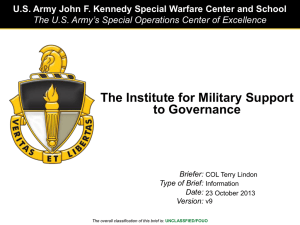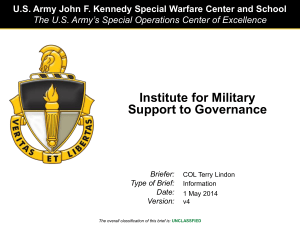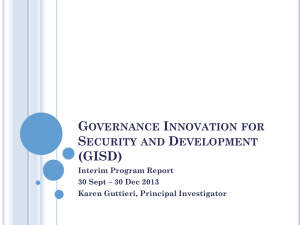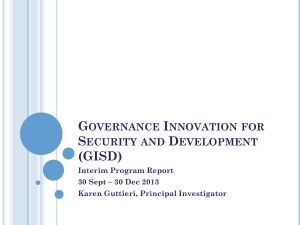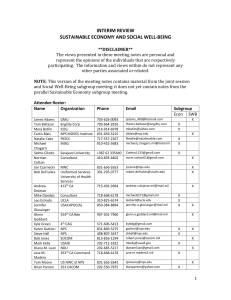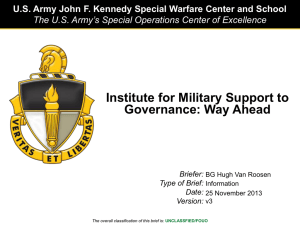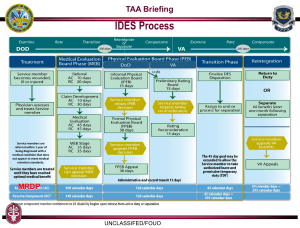IMSG Revised 15JUL13 Working
advertisement
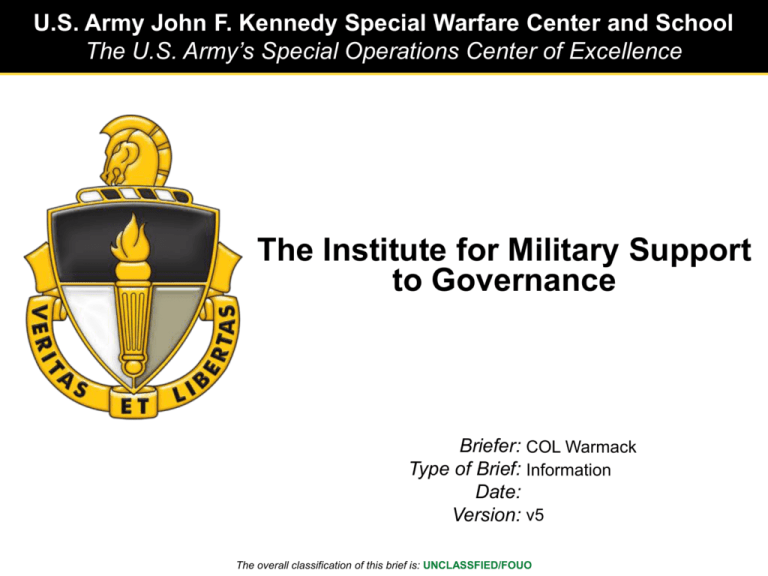
U.S. Army John F. Kennedy Special Warfare Center and School The U.S. Army’s Special Operations Center of Excellence The Institute for Military Support to Governance Briefer: COL Warmack Type of Brief: Information Date: Version: v5 The overall classification of this brief is: UNCLASSFIED/FOUO BACKGROUND UNCLASSFIED/FOUO 2 Historic Roots • WWII - Civil Affairs and Military Government was a single organizational structure designed to conduct occupation duty in Europe and Asia. The • The School of Military Government (SOMG) was established in Charlottesville, Virginia in 1942. • The SOMG lacked capacity throughput to meet demand, therefore establishing the Civil Affairs Training Schools (CATS) at premier academic institutions such as Harvard, Yale, Princeton, Stanford, University of Michigan, etc. • The SOMG and CATS generated approximately 6,000 Military Government officers. • The SOMG and Military Government capability eroded due to lack of demand in Cold War conflicts like Korea and Vietnam. UNCLASSFIED/FOUO 3 Functional Specialist Program • The concept of Functional Specialists derives from our history in World War II – Civil Affairs and Military Government, to conduct occupation duty in post-war Europe and Asia • Relied upon the inherent civilian skills brought into uniform • The current model is flawed due to – o Alignment with Unified Action Partners operational lines o Depletion of historical inventory of experts due to retirements and operational tempo o An inability to procure veritable talent and deliver the right skill, at the right place, at the right time o An inability to adjudicate a practitioners capability to plan and execute at the local, provincial, or national / regional level UNCLASSFIED/FOUO Veritas et Libertas4 Why Military Governance? The Blueprint National Defense Strategy, Sustaining U.S. Global Leadership: Priorities for 21st Century Defense – Deter and Defeat Aggression (A Primary Mission of U.S. Armed Forces) . . . “includes being able to secure territory and populations and facilitate a transition to stable governance on a small scale for a limited period using standing forces and, if necessary, for an extended period with mobilized forces.” DoDD 5100.01 Functions of the DoD and Its Major Components – Directs the Army to “occupy territories abroad and provide for the initial establishment of a military government, pending transfer of responsibility to other authority.” DoDD 3000.005 Stability Operations – Directs DoD components to Conduct, Support, or Lead Stability Operations. JP 3-07 Stability Operations – Defines Transitional Military Authority as “a temporary military government exercising the functions of civil administration in the absence of a legitimate civil authority.” JROCM #162-11 CA DOTMLPF Recommendation – Doctrine, Organizational, and Personnel changes to CA formations in general and CA Functional Specialty capabilities in governance, economic stability, public health and welfare, rule of law, infrastructure, public education, and public information. FM 27-10 Law of Land Warfare – The legal authority for military government or transitional military authority is the Hague Convention, Number IV in 1907. ADRP 3-07 Stability Operations – Army doctrine in conducting transitional military authority. UNCLASSFIED/FOUO 5 IMSG generates the civil sector expertise for: PREVENT “…build the capacity of partners to secure populations, protect infrastructure, and strengthen institutions as a means of protecting common security interests, preventing conflict…” “…address shared interests and enhance partners’ security, governance, economic, development, essential services, rule of law, and other critical functions as part of unified action.” SHAPE “…engagement with partners to co-develop mutually beneficial capabilities and capacities to address shared global interests.” WIN “civil military operations in a multinational environment with partners and among diverse populations to support allies and partners, protect and reassure populations, and isolate and defeat enemies within the operational environment in support of unified action.” (Army Capstone Concept, 19 DEC 2012) UNCLASSFIED/FOUO 6 Gaps Derived from JROCM 162-11 •The Army requires the capability to procure, educate, and incorporate the necessary civil sector expertise to integrate and support Unified Action planning and execution. •The Army requires a mechanism to capture lessons learned, cross-pollinate best practices with Unified Action Partners, and develop concepts that foster efficient integration and transition. • The Army requires the capability to manage a network of relationships in order to leverage the private sector. UNCLASSFIED/FOUO 7 Developing a way ahead for IMSG • Received Hon. Thomas Lamont (Assistant Secretary of the Army JUN 2011 for Manpower and Reserve Affairs) Memorandum • Reviewed Joint Requirements Oversight Council (JROC) Civil Affairs DEC 2011 DOTMLPF Change Recommendation Memorandum • Met GEN Rodriguez (CDR, FORSCOM), LTG Cleveland OCT 2012 (CDR, USASOC), LTG Talley (CDR, USARC / Chief, USAR) • Presented US Institute of Peace FEB 2013 • Collaborated US Army War College, West Point Center for FEB 2013 Civil-Military Operations, DoS Bureau of Conflict and Stabilization Operations • Briefed LTG Cleveland (CDR, USASOC) MAR /APR 2013 • Briefed USARC / OCAR Senior Leaders MAR 2013 • Submitted 38G Military Occupational Classification & Structure Packet JUN 2013 • Briefed LTG Talley (CDR, USARC / Chief, USAR) JUL 2013 UNCLASSFIED/FOUO 8 PHASE I UNCLASSFIED/FOUO 9 IMSG Mission – Phase I Mission – The Institute for Military Support to Governance (IMSG) establishes a corporate body to research, analyze, and shape the policies, authorities, and doctrine required to leverage and employ civil sector expertise in contingencies. Functions – • Shape policy and develop doctrine and training related to civil sector expertise. • Leverage the private sector UNCLASSFIED/FOUO 10 IMSG Phase I Timeline PHASE I KEY TASKS – 1. “Get the shingle out” 2. Distribute white papers 3. Research, analyze and shape policies, authorities, and doctrine Publish First White Paper IMSG Initial Team in place JUN 13 JUL 13 BG Director identified and in-place Develop MOU Develop Draft Charter AUG 13 SEP 13 OCT 13 NOV 13 Develop IMSG TDA DEC 13 JAN 14 FEB 14 Determine Charter Members Facilities Established Publish Charter MAR 14 PHASE I OUTCOME – • 38G Implementation • Doctrinal Production UNCLASSFIED/FOUO 11 IMSG Proposed Structure Aide-De-Camp TPU / AGR 38A CPT Academic Dean Director Institute for Military Support to Governance US Asst Dean GS-14 Operations & Integration Section Deputy Director, AGR 38A COL Private Sector Integrator 38 A MAJ Essential and Humanitarian Services Dept Operations Officer, AGR 38A MAJ Director USAR COL Director USAR COL Director USAR COL Director USAR COL Director (Econ) USAR COL Director USAR COL Asst Operations, DA Civilian Lead Coord AGR 38A LTC / MAJ Lead Coord AGR 38A LTC / MAJ Lead Coord AGR 38A LTC / MAJ Lead Coord AGR 38A LTC / MAJ Director (Infra) USAR COL Lead Coord AGR 38A LTC / MAJ Asst Operations, AGR 38A CPT Partners – -USAID -Dept of Education Partners – -Military Police -Maneuver COE -National, state, and local law enforcement entities Partners – -DOS -USAID -JAG -Court systems Partners – -DOS -USAID -State Government -Local Government Operations NCO, AGR E8 Civil Security Department Rule of Law Department Governance Department Lead Coord AGR 38A LTC / MAJ Partners – -USAID -USACE -Department of Agriculture -Chamber of Commerce Public Affairs Officer, MAJ USAR TPU / IMA UNCLASSFIED/FOUO USAR AGR DAC (USASOC) Economy and Infrastructure Department AC Homeland Integration Department Partners – -DHS -Private/Public Partnerships AGR 12 PHASE II UNCLASSFIED/FOUO 13 Proposed IMSG Mission – Phase II Mission – The Institute for Military Support to Governance (IMSG) is corporate body to research, analyze, and shape the policies, authorities, and doctrine; manages and leverages a network of relationships; conduct professional credentialing of Military Governance Officers; and support concept development for experimentation in order to provide civil sector expertise to the Joint Force Commander and achieve Unified Action. Functions – • Shape policy and develop doctrine and training related to civil sector expertise • Leverage our ‘Fifth Force Provider’ – the private sector • Extend operational reach • Identify and coordinate with pertinent credentialing associations • Establish advanced educational opportunities at premier academic institutions • Perform talent management UNCLASSFIED/FOUO 14 IMSG Proposed PH II Timeline PHASE I KEY TASKS – IMSG Initial Team in place Brief Key Decision Makers 1. “Get the shingle out” 3Q FY 13 2. Distribute white papers 3. Research, analyze and shape policies, authorities, and doctrine 4Q FY 13 3. Inject 38G capabilities into concepts and experiments BG Director identified and in-place FDU 2Q FY 14 PHASE II KEY TASKS – 2. Develop Doctrine and Training MOCS Packet thru HQDA 1Q FY 14 3Q FY 14 1. Establish credentialing for 38G Facilities Established 4Q FY 14 IMSG develops recruit and credential plans CA Proponent Implement DOTMLPF solutions for 38G 1Q FY 15 2Q FY 15 3Q FY 15 Set conditions to recruit and train 38G 4Q FY 15 IMSG UNCLASSFIED/FOUO 38G 15 Distinct Roles and Functions Peacekeeping and Stability Operations Institute FOCUS – Serve as the U.S. Army’s Center of Excellence for Stability and Peace Operations at the Strategic and Operational levels in order to improve military, civilian agency, international, and multinational capabilities and execution. Center for the Study of Civil-Military Operations FOCUS – • Developing West Point leaders to capitalize on their understanding of CMO within the framework of the broad challenges they will face in military service. • Facilitate transformational changes to Professional Military Education across DoD and interested USG activities. • West Point established as a wellspring of Professional Military Education in the realm of CMO. Institute for Military Support to Governance FOCUS – Phase I – A corporate body to research, analyze, and shape the policies, authorities, and doctrine required to leverage and employ civil sector expertise to support Army and Joint Force Commanders at the tactical, operational, and strategic levels. Phase II (Proposed) – A corporate body to research, analyze, and shape the policies, authorities, and doctrine; manages and leverages a network of relationships; conducts professional credentialing of Military Governance Officers; and supports concept development for experimentation required to leverage and employ civil sector expertise to support Army and Joint Force Commanders at the tactical, operational, and strategic levels to achieve Unified Action. Veritas et Libertas IMSG and CMAG UNCLASSFIED/FOUO 17 IMSG is a component of CA Futures Planning CA Org. Future Force Structure Concept CA Reassignment Initiative IMSG Concept CivilMilitary Advisory Group (CMAG) CA Future 38G Concept Future Core Competencies 3-57.40 Rewrite UNCLASSFIED/FOUO 18 Civil Military Advisory Group • Part of SOCOM’s effort to expand the Global SOF network and ARSOF 2022’s vision of “Operationalizing the CONUS base” • Established national-level forum for stakeholders for civil-military collaboration, integration and planning that can analyze, inform and develop strategies across the spectrum of conflict and emerging crisis. • Incremental build beginning with the establishment of a CMAG cell within the SOCOM CCF structure. • The CMAG cell would work to build and sustain relationships for collaboration, integration and planning capability to support activities at both the operational and tactical level. • In an ambiguous and complex environment the CMAG will systematize the relationships and mechanisms required to better integrate whole of government (Unified Action Partners) and other relevant partners’ efforts in support of USG objectives. CMAG is not a duplicative effort but complementary to meet operational requirements. Unified Goals Institute for Military Support to Governance Common Goals Civil Military Advisory Group Information Analysis and Fusion Procure Talent Coordinate with Stakeholders Standing Expertise Academic Research Cross-Pollinate Best Practices Educational Opportunities Establish Credentialing Gates Operational Support Experimentation Concept Development Veritas et Libertas Operational Framework GEF Department of State (DOS) USSOCOM F PROCESS Current Gap Relevant Partners USAID CONPLAN 7500 95th Civil Affairs Brigade (Airborne) CMAG GCC MSP Theater CMSE TSOC TSCP TSOC Forward SOF CA BN CAPT SOF CA Company CMOC US Embassy COP USEMB Country Team CMSE DOD GWOT Campaign Construct/ 7500 Indirect Approach Shape and Stabilize 1. Enable Partners to Combat VEOs 2. Deter Tacit and Active support to VEOs 3. Erode Support for Extremist Ideologies Increase Friendly Freedom of Action Reduce Enemy Freedom of Action SOF CA Team (CAT) Function: Support TSOC planning efforts; Coordinate SOF CA ISO TSOC Objectives; Build Partnership activities; Provide Civil Component of TSOC OPE; Coordinate Crisis Response. Function: Provide Civil Component of OPE; Fuse CMSE/CAT CIM data ISO Regional Targeting Priorities; Develop plans to engage threats to civil society by, with and through legitimate indigenous authorities IOT reduce, mitigate and eliminate civil vulnerabilities. Function: Conduct Targeted CAO; Conduct CIM; Leverage Country Team programmatics, HN assets and NGO capabilities ISO TSOC Objectives. Preventative Engagement Non-Conflict Environment PHASE 0 Conflict Environment IMSG Concept Potential Scenario: Crop Failure in Sudan JTF HOA soldiers report wheat crop failures in rural South Sudan Harvard Kennedy School of Government Naval Postgraduate School Hoover Institution Stanford University Northwestern Center for Public Safety US Army PKSOI USAID AFRICOM DOS UVU Institute of Emergency Services and Homeland Security Notre Dame School of Business UNC Institute for Global Health & Infectious Diseases IMSG USC Keston Institute for Public Finance and Infrastructure Policy Institute Of Peace National Defense University CMAG USCAPOC Borlaug Institute for International Agriculture Texas A & M Kenya Agricultural Research Institute JTF HOA Stem rust is a fungus that damages wheat and other cereal crops. In recent years, a particularly virulent strain (Ug99) emerged in Uganda and is currently spreading to Kenya, Ethiopia, Sudan and Yemen. Ug99 is becoming more virulent as it spreads. This strain of stem rust fungus causes crop yield losses of 50 to 70 percent resulting in food insecurity, population vulnerability and, without intervention, famine. Ug99 is a threat to global agriculture and the global food supply. UNCLASSFIED/FOUO 22 38G UNCLASSFIED/FOUO 23 IMSG supports 38G Concept Development CA Org. Future Force Structure Concept CA Reassignment Initiative CivilMilitary Advisory Group (CMAG) IMSG Concept IMSG Required Capabilities CA Future Future Core Competencies IMSG 38G Concept 38G Required Capabilities 3-57.40 Rewrite UNCLASSFIED/FOUO 24 IMSG Phase II: 38G (No Growth) 21 Grade O6 O5 O4 O3 38A 41 159 433 974 38G 21 187 240 132 Total 62 346 673 1106 Total 1607 580 2187 187 38G 240 132 62 346 673 41 1106 159 Current 38A 38A 433 974 38G positions derived from existing 38A functional specialty authorizations UNCLASSFIED/FOUO 25 38G Professional Tiering UNCLASSFIED/FOUO 26 Master 38G Professional Tiering Positions coded w/SI for professional expertise and specialty skill Bachelors Bachelors Education Expert Senior *Masters 12 Yrs Exp Terminal Professional Certifications 8 Years Experience Professional Certifications *4 Years Experience *Professional Certifications * Requires two Basic Masters Master Recognized Expert in Field PhD UNCLASSFIED/FOUO Distinguishes professional abilities for effective employment >4 Years Experience Experience / Certifications 27 IMSG Logic Map for Phase I IMA (MOB) Coordinate w/ USARC and SLDO Transfer Positions to SWCS Reserve TDA AGR Coordinate w/ USARC G-3 Direct Military Overhire Auth GS Civilian Position Description & Org Chart ID Requirement & Authorization Initial Talent Recruitment IMSG Concept IMSG Provisional TDA 38G Concept 38G Required Capabilities IMSG Location (Irwin Middle) Refurb Work Order IMSG Required Capabilities Transfer Positions to SWCS AGR TDA Submit Civ Workforce Management Council Packet IMSG Troops to Task Analysis IMSG Tasks Identified Personnel Vetting Proposed IMSG TDA Orders Process Orders Process Classification Request for Personnel Action SWCS, USASOC, TRADOC, DA approvals IMSG in ARSTRUCT Start Work Project complete QA/QC Hiring Board IMSG POM Line Publish Charter SWCS submits to DPW($8K) (OCT13) Design Plan DoD Schools vacate (JAN14) Establish Funding Accounting Procedures Determine Funding Source Submit to Critical Requirement Review Committee UFR Board or VOCO Submit UFR Contracting MIPR DPW Reoccupy IMSG Occupy Temporary Offices Occupy IMSG As Is Informs Gain Line of Accounting for Provisional TDA Leads To PHASE I KEY TASKS – 1. “Get the shingle out” UNCLASSFIED/FOUO 2. Distribute white papers 3. Research, analyze and shape policies, authorities, and doctrine 28 IMSG Required Capabilities Doctrine Develop 38G / application of civil sector expertise doctrine Organization Input 38G / civil sector expertise to the Force Design Update Process Facilitate interaction between civil sector experts and Unified Action Partners Training Coordinate IET for accessing 38G, Inform development of 38G BOLC II Material Inform Force Development Update regarding Mil-Gov requirements Leadership & Education Identify and Inform education opportunities on the application of civil sector expertise within Unified Action. Personnel Manage personnel life cycle of 38G in conjunction with CA personnel proponent Facilities CAAF through 2018 Policy Identify suboptimal Mil-Gov and Military Support to Governance policies and initiate corrective action UNCLASSFIED/FOUO 29 Backup UNCLASSFIED/FOUO 30 IMSG Summary The Institute for Military Support to Governance – • Creates the capability to meet long standing US military governance obligations • Generates the civil sector expertise required to support future operations • IMSG Phase I (no growth) – Focuses on policies, authorities, and doctrine • IMSG Phase II – Generates 38G (converts existing 38A force structure) • Credentials civil sector experts • Develops 38G doctrine and training • Supports concept development and experimentation • Establishes advanced educational opportunities at premier academic institutions • Performs talent management of civil sector experts • Supports operational practitioners with situational research and analysis UNCLASSFIED/FOUO 31
